Diary of an Adventurous Lady
Monday, January 30, 2006
Sunday, January 29, 2006
Surprise! I have wireless access at Guajome.
 Sunday afternoon, Jan. 29
Sunday afternoon, Jan. 29On Friday, I opted to keep my rental car for another day. First I spent a few hours at Barnes and Noble for Internet access ($3.95 for two hours connection, and worth every penny). I also did some shopping, ran a couple errands, and had a delightful lunch with my granddaughter Christine (my other 21-year old).
That evening I met Mary Jane (Halbig) and Lee Rife for dinner and a great visit. It was a time that Mary Jane will always remember. We had just sat down, been given glasses of ice water – and the next thing she knew, I accidentally knocked my ice water over and, after flooding the table, it ended up in her lap.
Yesterday (Saturday) several local friends visited me here at Guajome. First Dorothy and Jake Schwanner came by with coffee, brownies, chocolate chip cookies and grapes. What a treat! I met the two of them during my many years of country/western dancing.
They no sooner left than LeRae and Tom Moore (also c/w dance friends) drove up. And not too long after that Renee Scott (a friend from Riverview EV Free Church) joined us. What a great time with special people. Renee and I ended the day with a long walk on the Guajome trails.
This morning I took some bread and walked to the lake to feed the ducks, geese and coots. There are some might strange looking critters here (photo).
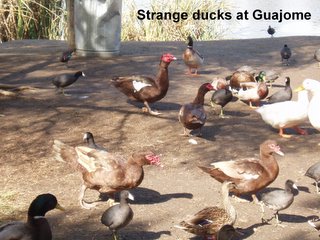
Cat has given up on going outside, and mostly naps. She sure konks out in some unusual positions.
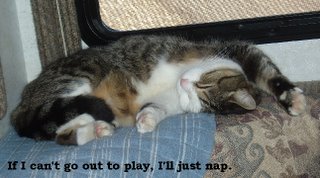
Today I was wishing that I could have access here at Guajome. On a whim, I tried – and was surprised to find myself connected! I’m not sure where the signal is coming from, and it is weak, but it is here. I’ve been able to check my email, get some writing work done, and now I can post to my blog again. Hooray!
I also took some pictures of my motorhome.

It has been good to have time to read. This morning I finished Eugenia Price’s autobiography. As I got closer to the end, I found myself slowing down to make the book last longer!
I also have been collecting more pithy statements. Here’s one for you.
Comparison is the kiss of death of gratitude. When you start comparing your lot in life to somebody else's you stop being thankful for what God has given you. Comparison will stop gratitude every time." --Dr. Michael Easley
This evening I'm going to my son's to prepare homemade New Mexican enchiladas for his famiy. They live just a few miles away.
Tomorrow I leave Guajome to stay a few days at the friends Pat and Russ Vollman (they live in Escondido and have room for my motorhome). I’ll be back here at Guajome next Friday afternoon until Monday morning. I’d love to hear from you from time to time. Send email to carolinnewmexico@azulstar.com
Thursday, January 26, 2006
Happy Campers at Guajome
Tuesday, Jan. 24
It was a delightful drive from the desert - up the backside of Julian (a small town famous around here for apples), and then down through Santa Ysabel (even smaller town that is famous around here for Dudley's Bakery). I was looking forward to buying some bread, totally forgetting that it is closed on Mondays and Tuesdays.
Highway 78 - which for the most part is a two-lane scenic drive with little traffic - becomes a six-lane southern California racetrack as it goes from Escondido almost all the way to the coast. After two stops, Rubios for a fish taco and Walmart for some birdseed, I pulled into Guajome Park. And I congratulated myself for having the foresight to make reservations because the sign announced: "campsite full." After several tries, I got Jeremiah backed into the space (had to keep all wheels on the blacktop while leaving enough room for my slideout) and level. The RVs are nicely spaced out.
Night temperatures get down in the high 30s and daytime temps warm up to the 60s. A big difference is the humidity, which is about 65 percent. It was about 20 in the desert.
It's interesting that even locals don't know about Guajome. It is one of the richest riparian areas of any county park. It has spring-fed lakes and a marsh that have water-loving vegetation. Reportedly about 144 bird species have been spotted here. There are several miles of hiking trails. Historically it was part of a land grant and it has a 140-year old adobe ranch house that is nearly 7,000 square feet and has 22 bedrooms. The RV portion has water and electric hookups for 41 RVs.
Cat is beside herself with so many critters to watch. She goes from window to window chattering at birds, ground squirrels and rabbits - and really wishes she could go out.
Wednesday, Jan. 25.
Today is house-cleaning day. I got out my trusty dust-buster (thanks again, Irene - it sure comes in handy) and then dusted and washed the linoleum portions of the floor. This doesn't take too long, so I had plenty of time to explore the park and hike some trails. My friend Sandy picked me up and we went to her home for dinner.
Thursday, Jan. 26.
Today I had a rental car to get me to some medical checkup appointments and to do some shopping. I got an "all OK" from my oncologist, and my dermatologist removed two small moles.
Monday, January 23, 2006
I'm stunned. I'm speechless. I'm ...


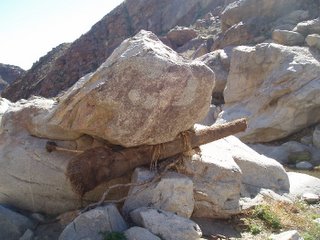
This morning I hiked the 1 1/2-mile trail to the First Palm Grove in Palm Canyon. I've made this 3-mile round trip hike at least 50 times during my 11 years as a Bighorn Sheep Census Volunteer. Today was the first time I've hiked it since the canyon flooded in 2004 and 2005.
The "old" trail
Here's a description of the "old" trail, which goes up Palm Canyon: It was a well-defined, and well-used trail. The first one-third of the trail was a gently rising sandy path. It crossed a bridge over a usually dry creek. The next third, steeper than the first part, was partially sandy and partially rocky. At the end of this section, a hiker got the first look at the palm oasis in the distance. The last third of the trail crossed another bridge over the often-dry creek before getting steeper. Hikers had to go over and around good-sized boulders.
Along the entire trail were a few scraggly trees, numerous cacti, desert bushes and grasses. The canyon gradually narrowed. In the midst of a bunch of palm trees at a narrow point, a trail arrow showed that the trail again crossed the creek - no bridge here - requiring rock-hopping while dodging low-hanging palm fronds. The trail continued up and over rocks until it came to a promontory that overlooked the creek and trail below. It was here we set up our sheep-counting camp on a good-sized level dirt area. From this place, we could watch both sides of the canyon. There were many palm trees around this area.
The "after-the-flood" trail
I had heard that the flood had drastically changed the trail, but I was not prepared for what I saw. The area definitely shows the power of water. Here is what the area was like today: As soon as I left the RV camping area, I started seeing trunks of palm trees scattered and stacked like pick-up sticks. Many of the rock and wood cabanas were destroyed. Before even starting up the trail, what once was a shallow dry creek is now a scoured, wide and deep-in-places flowing creek. The first two thirds of the trail bore little resemblance to the old one. It somewhat parallels a new, deep gorge with the creek at the bottom. Both bridges were gone, so I had to rock-hop my away across the creek.
All along the way were piles of debris from the plant growth that had been ripped from the sandy soil; and a LOT of palm tree trunks were scattered. The last third of the trail gains altitude as it hugs the side of the rocky canyon wall, and the trail itself was only slightly changed. Except that now the canyon is much deeper because it seems like most of the sandy soil was washed away. I kept expecting to see the palm trees for the last trail crossing - but there were none. Absolutely none! And, the promontory I sat on so many times to count sheep also was gone - washed away down to bedrock. I stood there, looking around in utter amazement. I was stunned. I sat on a huge boulder to let it all sink in and took some pictures.
The picture with the palm grove in the background: These palm trees were a couple thousand feet behind our counting site; and we could not see them from the site. So, the area in the foreground of the picture used to be the level, dirt promontory.
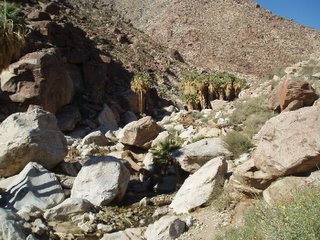
I got back to Jeremiah shortly after noon. I made a delicious salad using the lettuces and other veggies I bought in Yuma. I took my lunch outside on the picnic table, and let Cat out to explore. There are hundreds of birds and chipmunks. Cat was content to just watch them, perhaps calculating the odds of actually catching one.
It was a beautiful day - not too hot - and many RVers were sitting outside. So, after lunch, I put Cat in the motorhome and set out to walk around and meet neighbors. I talked to Iris again and learned that this is her first solo trip into the USA. Next I met Mary Ann Multer. She also travels solo and has a small, older Winnebago Class C. She lives and travels full time. Mary Ann is just starting a stint as the camp host. Her next volunteer assignment is a park somewhere in the Blue Ridge Mountains. We've exchanged email addresses and will be keeping in touch.
Just as I was making my last walk around the park, I came upon Charlie and Clari Clapp. They are both 75 years old, have a home in Salt Lake City, and take trips in their fifth-wheel. We got acquainted while we made another lap of the park. We were still deep in conversation, so when we neared their RV, they invited me to have dinner with them. When Clari mentioned that she had been a tennis pro and had worked for Prince Mfg., we started comparing notes. She knew ATS and USRSA (both tennis-related companies that my husband Rick and I had started); and we both knew many of the same people in the tennis industry. They are such interesting and active people - more proof that the "older ages" are not necessarily "old."
In the morning, I'll leave for the coast. I have a reservation at Guajome County Park.
Sunday, January 22, 2006
Break out the shorts and t-shirts - I'm in warm weather again
At least for the next couple of days I'll be warm. I think it is safe to say that I won't have really cold days or below freezing nights until I get back to New Mexico! Yuma's winter weather was downright chilly - days and nights. Even the snowbirds, who usually expect warm weather in Yuma, were complaining. Today I'm in Anza-Borrego State Park, and it was a nice really warm/but not beastly hot day. I enjoy this RV park because the spaces are spread out; not packed in tightly like they are in so many commercial RV "resorts".
I had a nice, and fairly short drive from Yuma to the Borrego desert. When I arrived, the ranger told me a search-and-rescue operation was going on in Palm Canyon, and the trail would be closed until the rescue was finished. Search and Rescue teams, including dogs, were combing the area for two hikers who were overdue from a "day" hike they had started the day before. The female was brought down about 2 p.m., and the male was found and brought down about 5 p.m. Both were in good shape - surviving a cold night and lack of water.
Once I was settled into space 43, I took a walk along the park roads and then unloaded my bike and rode to the visitors' center. This afternoon I met Iris - a single woman traveler from Canada. I also enjoyed meeting and talking to Beth who is a parks volunteer at the kiosk where campers and day-use visitors check in and pay fees. Beth and her husband are from the East, spending winters here at Borrego as volunteers.
Saturday, January 21, 2006
Yuma - Winter Lettuce Capital of the World!
And Yuma may not be THE snowbird capital of the world, but it must be among the top 10. It appears that lettuce (and other produce) and snowbirds are the major industries of this Arizona town.
Lettuce Days
I learned a lot about Yuma's produce industry at Lettuce Days. This street fair was typical - vendors selling "stuff" and decorative items that will soon adorn those "planted (im)mobile homes; things for snowbirds' adorable grand- and great-grand children; hats, t-shirts and sweatshirts (sweatshirts sold well because it was quite chilly); less-than-healthy stuff to eat - mini-doughnuts, kettlecorn, hotdogs, pizza, ice cream, and Indian frybread. (No burritos!) The one healthy meal was served up by the Border Patrol Explorers: grilled, skinless chicken breast, along with home-cooked beans and rice, tortilla and salsa. Also in the healthy-food department, the Yuma Food Bank was selling just-picked produce and a high school band was selling bags of oranges.
Besides the street fair vendors, there were several special attractions on Saturday. First was the Kids Lettuce-Box Car Derby. The five entries individually coasted the length of two blocks in a timed competition. (Photos)

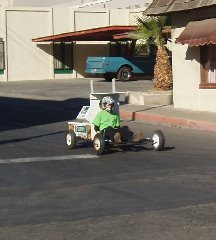
The Hidden Valley Ranch Dressing competition apparently wasn't well promoted - there were only three entries. The only requirement was that the recipe had to include at least one packet of the dry salad dressing mix. (see photo of winner). I was one of six judges. The first two entries were quite tasty, looked appetizing, would appeal to all ages, and were relatively simple to make. The third entry flunked ALL categories - it was a spinach soufflé.

I had fun walking through the tractor displays and overhearing conversations by the many retired farmers/snow birds. I learned that the huge tractors have GPS systems to keep the planting rows uniform and straight. Several tractors had tires taller than most of the spectators. (photo)
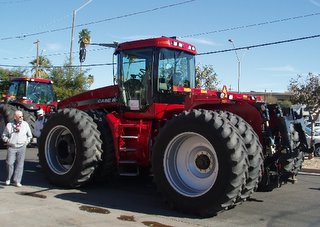
Saturday also featured the "produce house" - best left to photos to explain. (photos)
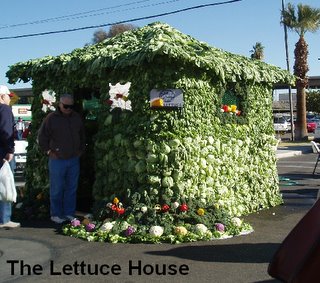
 The second photo was taken from the inside, looking out.
The second photo was taken from the inside, looking out.And my favorite was the lo-o-ong salad bar. It was about 150-feet long and for $2 I had every edible green vegetable - all topped with Hidden Valley Ranch Dressing. The salad bar was a fund-raiser for a local mission. (photo)

Rodriguez is the major produce-growing corporation in the Yuma Valley, with about 5,000 acres under cultivation. Besides several kinds of lettuce, they grow 30 kinds of other vegetables, including cauliflower, broccoli, corn, celery, cilantro, kale, radishes, Brussels sprouts, asparagus, and scallions. They also plant cotton, alfalfa, wheat and some grasses.
Rodruguez grows produce - marketed under several names - for major supermarket and restaurant chains. In the summer, it takes 2 1/2 months from planting to harvesting lettuce; in the winter it takes 3 1/2 months. There always are at least two lettuce seasons, sometimes three.
Head lettuce is "field packed" into boxes that hold 24 heads; when packed, the box weighs about 50 pounds. Field workers walk behind a piece of machinery cutting the heads that meet size requirements, placing them in a plastic bag that has the name/logo of the buyer. Each field box costs $7 to produce: labor, seed, fertilizer, etc. The price of lettuce - and all produce - fluctuates daily depending on supply and demand.
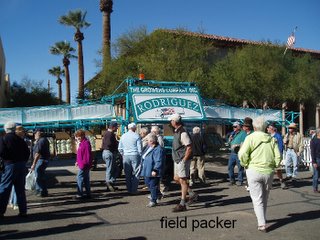
On any given day, the farm company uses 35,000 field workers. About 90 percent of the laborers are Mexican - some cross the border daily, some live in the Yuma area. I was told that they all have work permits/green cards.
Well, enough about Yuma and Lettuce Days. I had five very fun days. When I was not out and about exploring or chatting with neighbors at Friendly Acres, I read the book: Nothing to Fear; Lessons in Leadership from FDR," by Alan Axelrod. The book distilled Roosevelt's leadership qualities and courage it took to lift America out of the Great Depression and to steer our country through the dark days of WWII. Next in my reading pile is the autobiography of Eugenia Price, one of my favorite authors.
It's time to leave Yuma.
Thursday, January 19, 2006
Touring the Historic Yuma Crossing
Before this river was "tamed" by dams, The Colorado was a wild river. After cutting a deep path through the Grand Canyon, it flowed south, meandering uncontrolled where it at times grew to be 15 miles wide. As it came to what is known as Yuma today, two massive outcroppings of granite narrowed the river into a deep channel 400 yards wide.
The Colorado River effectively caused a division between the east and the west. The only feasible southern crossing was by raft and ferry at this narrow spot. This place became the "Yuma Crossing." In 1877 the first railroad bridge was completed. In 1915 the Ocean-to-Ocean Bridge was completed, linking the east and the west coasts to vehicle travel.
This was all fascinating to me as I watched a short movie at the Yuma Crossing State Historic Park. But the most fascinating was yet to come: learning about the Yuma Project and its "Yuma Siphon." It started with construction of the Laguna Dam north of Yuma. The Project was to divert water upstream, regulate water through a canal system in order to get water to California's Imperial Valley and Arizona's Yuma Valley for agriculture. After much study, engineers determined the best method would be to go underneath the Colorado River! In 1912, with diving bells, shovels and concrete, the tunnel was built underneath the river.
The Yuma Crossing was the site of the Quartermaster Depot, used by the US Army to store and distribute supplies for military posts.
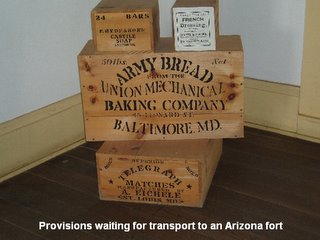
The self-guided tour through the facilities was interesting.
The Yuma Project opened a lot of land for homesteading.
During its construction, the Yuma Project received a large amount of publicity heralding the Colorado River as the "American Nile" and Yuma Project lands as among the most fertile in the world, needing only the touch of water. With such widespread advertising, lands opened for homesteading received far more applications than homestead plots available. For at least some of the homestead land openings, a drawing of eligible applicants determined awards for land.
One advertisement boasted: The finest winter climate on earth - a chance for investment, a chance for a home, sunshine the year around.
My morning and early afternoon exploration was by bicycle. I had lunch at a old town deli and then wandered through the area watching vendors get booths set up for the weekend festivities. Mid afternoon I set out on foot to find the WalMart that was supposedly not too far away. Well, it turned out to be a little more than 3 miles, one way - and it didn't have what I was looking for. So, today was a physically active day - 9 miles by bike and almost 7 miles on foot.
Tomorrow the 8th Annual Lettuce Days kick off at 10 a.m. My plan is to take my laptop computer, stopping first at the public library to post to my blog. Then I'll leave my bike locked up at the library, take my computer to the town's Visitor's Center for safe keeping while I roam the vendors and activity areas.
DID YOU KNOW? ARIZONA FACTS
State tree: Palo Verde - green bark, yellow flowers bloom late in Spring
State flower: Saguaro Cactus - blooms in May, opening at night, a few at a time on each plant, and remaining open until mid-afternoon on the following day.
State bird: Cactus Wren - medium-sized song bird. Its song, a repeated chug chug chug, sounds like a car engine trying to start.
State mammal: Ringtail - aka ringtail cat, miner's cat and cacomistle. They are not cats at all; closest relatives are raccoon and coatimundi. Has a large, bushy white and black ringed tail, fox-like face with huge, round eyes. NOTE: I saw a squashed one on I-8 near Gila Bend.
State amphibian: Arizona Tree Frog - small, green, gold or bronze color. Specially adapted disc-like pads at the end of each toe to aid in climbing.
State reptile: Arizona Ridge-nosed Rattlesnake - this beautiful, small snake rarely exceeds 2-feet in length. It is illegal to kill or possess this snake in Arizona.
State fish: Arizona Apache Trout - a beautiful, yellowish colored fish with uniform dark spots on the body. The fins are white or yellow tipped and there is a slash of orange on the lower jaw. It is listed as a threatened species.
NOTE FROM CAROL - please send your comments to me at carolinnewmexico@azulstar.com
Wednesday, January 18, 2006
The End of Martin Ubillos

"With his lips murmuring, but with a look of horror on his sensual, brutish face, Martin Ubillos was swung into eternity at the end of a rope in the Jail yard here last Friday at 10 o'clock." That is what the June 10, 1905, Arizona Sentinel newspaper wrote.
Martin's picture and the details of his incarceration at Yuma Territorial Prison was one of many - 3,069 - prisoners who involuntarily stayed here. Of course, not all were hung. A Mormon settler, Mr. Flake, was in prison alongside murderers, thieves, and other assorted "criminals" because of polygamy. He reportedly said, "It is far worse to have more than one wife than to commit murder." Between 1876 and 1909, the years the prison was in use, 39 of the prisoners were women.
When prisoners arrived, they were photographed before and after haircuts and shaves. Then they were issued uniforms made by Levi Strauss! Punishment for prisoners included the "dark cell" for those who broke prison regulations and a ball-and-chain for those who tried to escape. When in the dark cell, they received only bread and water. The entire prison complex, Arizona's first, was a pretty grim-looking place. It is now a State Historic Park, just a mile from Old Downtown Yuma. I spent several hours touring the prison.
Except for some canal bank bike paths, this part of Yuma isn't very bike-friendly. Mostly, I rode on sidewalks, taking advantage of the "handicap accessible" curbs at all the intersections. I rode about 16 accident-free miles total today. Tomorrow I'll tour the Yuma Crossing State Historic Park and either bike or walk the network of wetlands paths alongside the Colorado River.
Tuesday, January 17, 2006
Want to make a bag using Kool-Aid packages?
Yep, if you were here at Friendly Acres RV Park in Yuma, Arizona, you could do that. You'd also have an opportunity to make a square-stitch bracelet and decorate sweatshirts with jeans parts. Oh, yes, another announcement says, "Zipper art is pending!" Other park activities promoted in the January newsletter are: pool, shuffleboard, golf, water aerobics, and play Bingo.
Once a week there is a "concert" or other special event. This week "Larry Wayne Jones will sing his heartfelt songs and show clips from his videos." Friday from 4 to 6 p.m. residents will dance to music from The Kennedys.
Tomorrow evening (Wednesday) will be a Hamburger Potluck at 5. Yes, this is a large senior RV park. I estimate that at least 80 percent of the RVs have been "planted." They feature all sorts of add-ons: patios, carports, porches, etc.
People are friendly, the laundry facilities seem to be a buzz of activity, and the usual mode of transportation within this large park is either by bicycle or golf cart. I'll be here until Sunday morning.
My drive from Benson to Yuma was good. It was all Interstate driving - first on I-10 and then on I-8. I was pleasantly surprised that there is hardly any traffic on I-8 - at least on a weekday. Jeremiah cruised right along while I had plenty of time to enjoy the desert surroundings and recall events from the years I spent growing up in the Phoenix area. Driving I took the I-8 business route through Gila Bend. This town seems more spread out than I remember, but there didn't seem to be an obvious "down town." The café that is shaped like a spacecraft is still there.
It's been years since I drove through Yuma - it sure has grown. About 15 miles east of town new RV Resorts have sprung up, stretching several miles along I-8. It looked to be wall-to-wall rigs, and because the parks are so new, there are no trees to speak of.
Once I settled into space 283, I bicycled into Old Yuma where the Lettuce Days events take place. For several blocks, Main Street has been turned into a pedestrian mall; many buildings have been renovated and now house antique shops, boutiques, cafes and coffee shops. I'm looking forward to exploring this area tomorrow.
I located the main library, and was happy to find out that they have free wireless Internet. So, I'll be able to take my laptop there to post to my blog.
WEAR YOUR BIKE HELMET! On my way back to the RV park, a sidewalk curb jumped out and caused me to take a spill. (Well, actually, I misjudged a turn and that caused the accident.) Fortunately I was wearing my helmet. The bike pedal and handlebars kept me from totally hitting the cement sidewalk, but my helmet (with head inside) did hit pretty hard. I picked myself up and continued riding - shuddering to think of the consequences if I hadn't had my helmet on. My elbow/forearm and my knee were hurting.
I'm very chicken when it comes to looking at injuries. Once back at my motorhome, they continued to hurt, but there was no blood on my denim shirt or my jeans. I didn't want to look. After a while, I gave myself a stern talking-to: "Carol, if you choose to be single, you must be able to take care of things such as this!" "But I take care of a lot of things, I just don't want to look!" "Well, get over it!" "OK! But I really don't want to!"
I got out my first-aid kit, found some antiseptic wipes, laid out gauze pads, tapes and band-aids and hoped for the best. Whew! I only had superficial scrapes; wiped them and put band-aids on. "Now, that wasn't so bad, was it?" I had some wine, read a while and then tucked into bed feeling proud of myself. Today reminded me of something I read that was attributed to Foster C. McClellan: (I don't have a clue who he is/was.)
"Trust yourself. Create the kind of self that you will be happy to live with all your life. Make the most of yourself by fanning the tiny, inner sparks of possibility into flames of achievement."
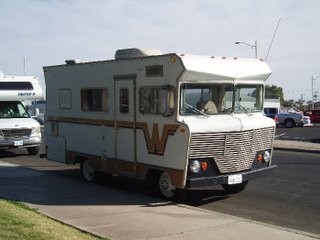
I also saw this old Winnebago parked next to the library.
Monday, January 16, 2006
Hunkering down in Benson
Nobody has things just as he would like them. The thing to do is to make a success with what material I have. It is a sheer waste of time and soul-power to imagine what I would do if things were different. They are not different. Frank Crane (American actor)
Given my druthers, I’d like the drive from Percha Dam to Benson to be super interesting, with lots of things to ooh and ahh over. But, that’s not the case. About halfway between Hatch and Deming, I always wonder about the “Middle of Nowhere Bar and Café.” I stopped one time, and not only is it in the middle of nowhere, there is nothing inside to remark about. (see photo)

The most fascinating part of the drive is going through Texas Canyon (between Willcox and Benson). For a few short miles, boulders are scattered and stacked – often precariously. Several huge ones look like they could topple down onto the Interstate at any moment.
Tonight I’m parked at Cochise Terrace RV Resort outside of Benson.
I have already modified my itinerary in order to be assured an RV parking space in Yuma that is near the old downtown where the Lettuce Festival takes place. I plan to arrive in Yuma tomorrow (Tuesday) afternoon. This will give me five days to explore the Yuma area.
Sunday, January 15, 2006
Three-plus days at Percha Dam State Park
Is a solo traveler just a person adrift? I’m always on the lookout for comments by others. Here’s what traveler and writer Daisann McLane had to say: “When I travel by myself, I feel more powerful than I do at just about any other time in my life. I alone decide what I will do and where I will go – and when. I enjoy being a woman on the road. I laugh, and I give thanks for the richly terrific life I get to experience.”
I echo her comment. It’s good to be on the road again. Jeremiah – my trusty Winnebago – is so easy and pleasant to drive. Cat is somewhere in the back, either napping or watching out a window. I left Rio Rancho about 10 a.m. on Thursday, Jan. 12. I stopped at my favorite lunch spot – Acosta’s Café in San Antonio (New Mexico) – for a green chile cheeseburger. They make them so much better than the “world famous” Owl Café.
I drove into Percha Dam State Park mid afternoon, and after being greeted by camp host Bob Nichols I settled into space #3. There are two other RVs, one belonging to Charlie and Sara a second set of camp hosts and the other to snowbirds Eleanor and Derrick. The snowbirds live in Wisconsin during the warm days and in Alamagordo (NM) in the winter. They both are birdwatchers, and make numerous three-to-four day birding trips to the southern New Mexico birding areas.
During my three-plus days here, quite a few very serious birders come and go. Besides expensive-looking binoculars and/or spotting scopes, they carry their bird identification books and their “life lists” of birds they have seen. I call myself a casual bird watcher, and enjoy the challenge of trying to figure out different species. I bought new binoculars (not the real expensive ones) before the trip, and they do help. But there are still some birds that I simply call LBB – little brown birds.
I took some winter pictures of the park – thinking I’d comment that they were taken “in the dead of winter.” Then I thought that was a strange saying, because it is anything but “dead” here. (see photo)

Here at Percha I go out early to stand in the meadow for the birds’ dawn chorus. It is surround-sound at its best! With so many species of birds here – more than 200 throughout the year – there are so many different sounds. I heard it said “the smaller the bird, the sweeter the sound.”
On Saturday, I met Paul Yoder, a volunteer who is manning the park’s Interpretive Center and leading nature walks for park visitors. On Sunday, I went with him for an early morning bird walk south along the Rio Grande. With his help I was able to identify a lot of my previously called LBBs. He also named trees, bushes, and grasses and together we tried to identify the many animal tracks.
I’ve had cold nights – between 18 and 30 degrees – and comfortable long-sleeve-and-jeans days. The only weather change was today. After a gorgeous morning, the wind blew and reportedly gusted up to 50 mph. The wind made it a good day to bird-watch from inside my motorhome. The slide-out with windows on three sides makes viewing easy. I saw a Yellow-bellied Sapsucker, Eastern and Western bluebirds, and some LBBs. It also was a good afternoon to stay inside to read, watch videos, and work crossword puzzles.
Each morning I awoke to the full moon shining in my bedroom window. And as daylight arrived each morning, another independent, solo traveler – a hen turkey – made her way south through the park. On one of my morning walks, I followed her tracks down a dirt path until they disappeared in a field. The camp hosts say she is always alone. Other morning regulars are the deer who travel north through the park – one or two does and two youngsters.
Bob and Joyce Nichols again invited me to be their guests for dinner on Friday night at the Eagles’ Lodge. The dinner theme was “Hard Times,” and the room was decorated to simulate a hobo camp. The meal was beer-brats, beans, coleslaw, fruit and for dessert, Twinkies and Moon Pies.
Tomorrow morning (Monday, Jan. 16) I continue on this trip. I’ll head south on NM Hwy 187 and west on I-10, stopping in Hatch, Deming, and Lordsburg (New Mexico), before stopping for the night in Benson (Arizona).
Wednesday, January 11, 2006
More Winter Adventures
For the past four weeks, I’ve been chomping at the bit to get out and travel again. Jeremiah has waited patiently while plugged into electricity at my friend Jesse’s home. We’ve had freezing nights, which can spell trouble for a non-winterized motorhome. (Thanks, Jesse).
Most of the motorhome is packed – am taking clothes for cold and warm weather! Tomorrow, Jan. 12, I’ll load perishables and Cat and we’ll head off for a 2,500-mile trip in seven weeks.
Highlights of the trip include:
-- Enjoying solitude time at Percha Dam,
-- Attending the Yuma (Arizona) Lettuce Festival where I’ll be a judge for the Hidden Valley Ranch Dressing cooking competition,
-- Staying two nights at Anza-Borrego State Park for hiking and warm relaxation,
-- Getting semi-annual medical checkups from my San Diego doctors,
-- Visiting family: son Rick Pray and his wife Dianne Pray, and granddaughters Christine and Danielle,
-- Watching granddaughter Danielle compete in a regional cheer competition in San Diego,
-- Visiting friends
-- Having lunch with my editor at the North County Times newspaper,
-- Touring a mushroom-growing facility in San Marcos (Calif),
-- Staying several nights at my favorite RV park, Guajome County Park (Vista/Oceanside)
-- Staying a few nights at the home of long-time friends Pat and Russ Vollman,
-- Spending an afternoon and night alongside the Colorado River at the Mayflower County RV Park (Blythe, Calif),
-- Spending a week in Apache Junction (Arizona) visiting family.
-- Meeting up with 43 other motorhomes for a week-long stay in Puerto Penasco, Mexico. Lots of beach time, shrimp, warmth, and friendship.
-- Returning home on March 1.
I’ll be posting every chance I get, but there will be days without Internet access. So, just keep checking. I leave you with this thought to contemplate:
Trust yourself. Create the kind of self that you will be happy to live with all your life. Make the most of yourself by fanning the tiny, inner sparks of possibility into flames of achievement. -- Foster C. McClellan
For your comments: email me: carolinnewmexico@azulstar.com



